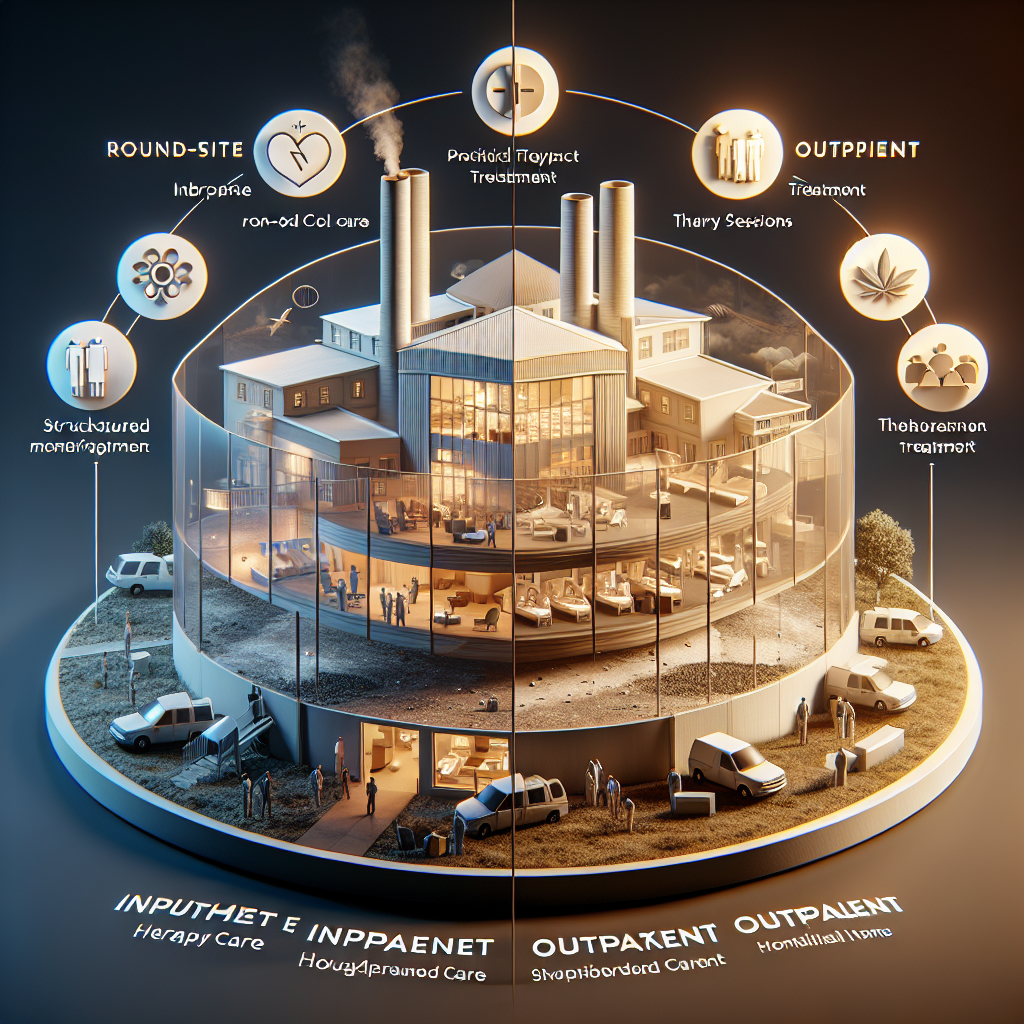-
Table of Contents

“Bridging Recovery: Hybrid Models for Comprehensive Addiction Treatment”
Introduction
Hybrid models that combine inpatient and outpatient addiction treatment are innovative approaches designed to provide comprehensive care for individuals struggling with substance use disorders. These models integrate the structured, intensive environment of inpatient treatment with the flexibility and continued support of outpatient programs. By blending these two modalities, hybrid models aim to offer a seamless continuum of care that addresses the varying needs of patients at different stages of their recovery journey. This approach not only enhances the effectiveness of treatment by providing consistent support and monitoring but also facilitates a smoother transition from intensive care to independent living, thereby improving long-term recovery outcomes.
Exploring Hybrid Models: Combining Inpatient and Outpatient Addiction Treatment
In the realm of addiction treatment, the journey to recovery is often complex and multifaceted. Traditional models of care have typically been divided into two distinct categories: inpatient and outpatient treatment. Inpatient treatment involves residing at a facility for an extended period, providing a structured environment with 24/7 support. Outpatient treatment, on the other hand, allows individuals to live at home while attending scheduled therapy sessions and support groups. However, as the understanding of addiction evolves, so too does the approach to treatment. Increasingly, hybrid models that combine elements of both inpatient and outpatient care are emerging, offering a more flexible and personalized path to recovery.
Hybrid models of addiction treatment are designed to bridge the gap between the intensive support of inpatient care and the flexibility of outpatient programs. These models recognize that recovery is not a one-size-fits-all process and that individuals may benefit from a tailored approach that adapts to their unique needs and circumstances. By integrating the strengths of both inpatient and outpatient treatment, hybrid models aim to provide a continuum of care that can enhance the chances of long-term recovery.
One of the key advantages of hybrid models is their ability to offer a more seamless transition between different levels of care. For instance, an individual may begin their recovery journey with a short-term stay in an inpatient facility, where they can receive intensive medical and psychological support. This initial phase can help stabilize the individual and address any immediate health concerns. Following this, the individual can transition to an outpatient program, where they continue to receive therapy and support while gradually reintegrating into their daily life. This step-down approach can help maintain the momentum of recovery while providing the necessary support during critical phases of the journey.
Moreover, hybrid models can be particularly beneficial for individuals with co-occurring mental health disorders. These individuals often require a more comprehensive approach to treatment that addresses both their addiction and mental health needs. In a hybrid model, the structured environment of inpatient care can provide the intensive support needed to manage acute symptoms, while the flexibility of outpatient care allows for ongoing therapy and medication management. This integrated approach can lead to better outcomes by ensuring that all aspects of an individual’s health are addressed.
Another significant benefit of hybrid models is their potential to reduce the stigma associated with addiction treatment. By offering a more flexible and personalized approach, these models can make it easier for individuals to seek help without feeling that they must completely disrupt their lives. This can be particularly important for those who have work, family, or other responsibilities that make a lengthy inpatient stay impractical. The ability to receive high-quality care while maintaining some degree of normalcy can encourage more individuals to take the crucial step of seeking treatment.
Furthermore, hybrid models can foster a stronger sense of community and support among individuals in recovery. By participating in both inpatient and outpatient programs, individuals can build connections with a broader network of peers and professionals. These relationships can provide invaluable support and encouragement, helping individuals stay motivated and committed to their recovery goals.
In conclusion, hybrid models that combine inpatient and outpatient addiction treatment represent a promising evolution in the field of addiction care. By offering a more flexible, personalized, and integrated approach, these models can enhance the effectiveness of treatment and support individuals in achieving lasting recovery. As the understanding of addiction continues to grow, the development and implementation of hybrid models will likely play a crucial role in shaping the future of addiction treatment, providing hope and healing to countless individuals and their families.
Benefits and Challenges of Hybrid Addiction Treatment Models
Hybrid addiction treatment models, which combine elements of both inpatient and outpatient care, are increasingly being recognized for their potential to offer a more flexible and comprehensive approach to recovery. These models aim to bridge the gap between the intensive, structured environment of inpatient treatment and the flexibility and real-world application of outpatient programs. By integrating the strengths of both approaches, hybrid models can provide a more personalized and adaptable path to sobriety.
One of the primary benefits of hybrid addiction treatment models is their ability to offer a continuum of care that can be tailored to the individual needs of each patient. Inpatient treatment provides a controlled environment where patients can focus entirely on their recovery without the distractions and triggers of everyday life. This level of care is particularly beneficial for those with severe addictions or co-occurring mental health disorders, as it allows for intensive therapy and medical supervision. However, transitioning directly from inpatient care to everyday life can be challenging, as patients may struggle to apply the skills they have learned in a less structured environment.
This is where the outpatient component of hybrid models comes into play. Outpatient treatment allows patients to gradually reintegrate into their daily lives while still receiving support and guidance from their treatment team. This step-down approach can help ease the transition and reduce the risk of relapse by providing ongoing therapy, support groups, and other resources. Patients can continue to work on their recovery while managing their responsibilities at home, work, or school, making it a more sustainable option for long-term sobriety.
Moreover, hybrid models can be particularly beneficial for individuals who have already completed an inpatient program but still require additional support. By participating in outpatient services, they can maintain their progress and continue to build on the foundation established during their inpatient stay. This ongoing support can be crucial in helping individuals navigate the challenges of early recovery and develop the coping skills needed to maintain sobriety.
Despite these advantages, hybrid addiction treatment models also present certain challenges. One potential issue is the need for effective coordination between inpatient and outpatient services. Ensuring that there is seamless communication and collaboration between different providers is essential for delivering cohesive and consistent care. Without this coordination, there is a risk that patients may receive conflicting information or experience gaps in their treatment, which could hinder their progress.
Additionally, hybrid models require a high level of commitment and motivation from patients. While the flexibility of outpatient care can be beneficial, it also means that individuals must take greater responsibility for their recovery. This can be difficult for some, particularly in the early stages of treatment when cravings and triggers are most intense. Therefore, it is essential for hybrid programs to include robust support systems and resources to help patients stay engaged and motivated.
In conclusion, hybrid addiction treatment models offer a promising approach to recovery by combining the strengths of inpatient and outpatient care. They provide a flexible and personalized continuum of care that can be tailored to the unique needs of each patient, helping to ease the transition from intensive treatment to everyday life. While there are challenges to be addressed, such as ensuring effective coordination and maintaining patient motivation, the potential benefits of hybrid models make them a valuable option for those seeking a comprehensive and adaptable path to sobriety. With the right support and resources, individuals can successfully navigate their recovery journey and build a healthier, more fulfilling life.
Q&A
1. **Question:** Are there hybrid models that combine inpatient and outpatient addiction treatment?
**Answer:** Yes, there are hybrid models that combine inpatient and outpatient addiction treatment, offering a continuum of care that includes both residential and outpatient services.
2. **Question:** What are the benefits of hybrid models in addiction treatment?
**Answer:** The benefits of hybrid models in addiction treatment include a more flexible and personalized approach, continuity of care, and the ability to transition smoothly between different levels of treatment intensity based on the patient’s needs.
Conclusion
Yes, hybrid models that combine inpatient and outpatient addiction treatment exist. These models integrate the intensive, structured environment of inpatient care with the flexibility and continued support of outpatient services. This approach aims to provide a comprehensive continuum of care, addressing the varying needs of individuals at different stages of recovery. By combining the strengths of both treatment modalities, hybrid models can enhance treatment outcomes, improve patient engagement, and support long-term recovery.



